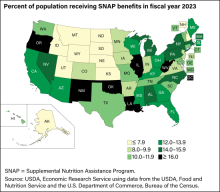
President Trump's massive tax and spending bill could have a dire impact on food and health benefits for low-income Hoosiers.
Why it matters: It's a historic cut to the social safety net, which Republicans claim will weed out waste, fraud and abuse. But others warn the move could leave more people hungry and uninsured.
The big picture: The "big, beautiful bill," signed July 4, includes cuts to the Supplemental Nutrition Assistance Program (SNAP, commonly known as food stamps) and health benefits for the poorest Americans.
State of play: Indiana may need hundreds of millions of dollars to keep SNAP benefits intact in the next fiscal year for the 600,000 Hoosiers who rely on it.
- State Democrats estimate the changes to SNAP will cost Indiana at least an extra $190 million, says Sen. Shelli Yoder on behalf of the Senate Democratic Caucus.
- "Passage of the budget reconciliation is undisputedly the most damaging federal policy targeting hungry Hoosiers that modern America has ever seen," said Emily Bryant, executive director of Feeding Indiana's Hungry.
Context: In addition to funding cuts, Trump's plan adjusts work requirements for SNAP.
- To keep their benefits, parents of children age 14 or older would have to meet new requirements. The bill also bumps the work requirement age up to 64.
- Currently, SNAP's work requirements for able-bodied adults without dependents apply to those age 18 to 54.
Threat level: The bill slashes over $1 trillion from Medicaid, putting coverage for 650,000 Hoosiers on the state's Medicaid expansion plan at risk.
- There are also concerns for nearly a dozen rural hospitals at risk of closure, including facilities in Rensselaer, Portland, Sullivan, Washington, Bremen, Winchester, North Vernon, Brazil, Salem, Decatur and Corydon, according to state Democrats.
- "People will die," Indiana Democratic Party chair Karen Tallian said in a statement. "Hundreds of thousands of Hoosiers are now at risk because they will lose access to food and health care."
Reality check: It's unlikely that state lawmakers will be able to cover the funding gaps.
- The two-year state budget passed earlier this year included major cuts to most state agencies in order to close a $2 billion revenue deficit.
